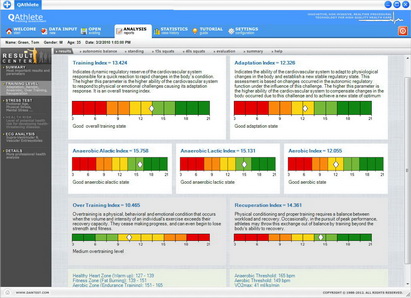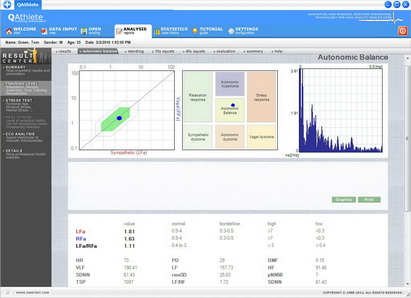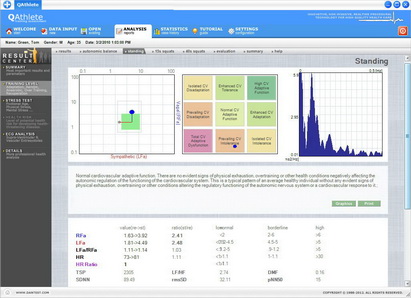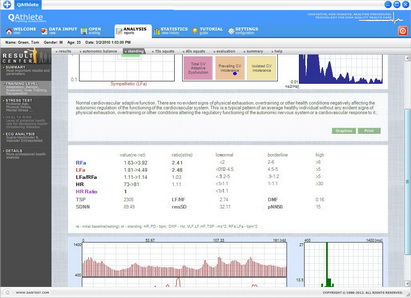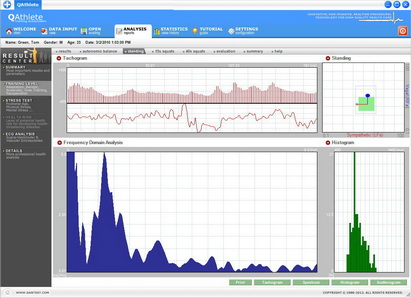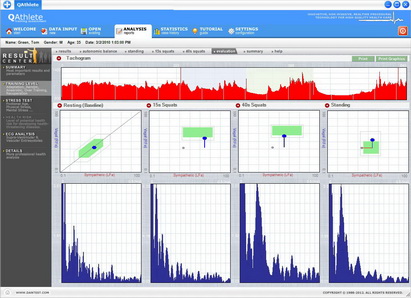Optimize Training and Recovery.
Workouts may not always have the intended effect.
Athletic Training Assessment
The QAthlete system utilizes a revolutionary approach for assessment of physical fitness. For over 30 years, the team behind QAthlete has been researching physiological effects of exercise, stress and recovery. Combining sophisticated software with state-of-the-art heart equipment, QAthlete transports the laboratory to homes, gyms, clubs and fitness centers worldwide.
The QAthlete system is easily installed on a desktop or a notebook computer and uses a heart rate belt or a ECG device to collect data for analysis. The system recognizes various states of physical fitness and generates quick reports based upon legions of data. Fitness evaluation by QAthlete includes the following:
* Overtraining index
* Recuperation index
* Overall training index/level
* Anaerobic alactic index
* Anaerobic lactic index
* Aerobic index
* Training adaptation index
* Resource depletion
* Stress reactions
This information provides an unprecedented level of control and predictive potential for fitness professionals, coaches, athletes and individuals.
Training Index
The cardiovascular system is responsible for quick reaction to rapid changes in the body's condition. The higher the cardiovascular system's reserves, the quicker the body responds to challenges - both physical and emotional. Training Index is an overall measure of the dynamic regulatory reserve of the cardiovascular system.
Additionally, the body uses different systems or pathways to fuel muscular contraction during training. In the course of exercise, athletes pass through various metabolic pathways based upon intensity and duration of the activities undertaken. QAthlete provides a basis for determining and understanding these parameters thereby enabling athletes to target condition and train more effectively.
QAthlete Training Indexes are based on an overall analysis of the following:
* Anaerobic Alactic Index
* Anaerobic Lactic Index
* Aerobic Lactic Index
* Overtraining Index
* Training Adaptation Index
Anaerobic Alactic Index
What is the Anaerobic Alactic System?
The anaerobic alactic system is the muscle's ability to produce energy without the immediate use of oxygen. The principle source of energy is phosphagens (creatine phosphate) and ATP (adenosine triphosphate) which are stored in the body and used as fuel through chemical transformations.
What Does the System Do?
This pathway is used in very short bursts of intense exercise or explosive, powerful movements up to 10 seconds long. When the activity extends beyond this time, a different pathway will be tapped for energy. An example of this system would be sprinting for 100m or swinging a golf club.
Training the System
Training this system requires 100% maximum effort in intervals. To place a stress on this system, look to either increase the duration or decrease the time allowed to recover or combinations of both.
Benefits of Anaerobic Alactic Index
This index provides information about the body's ability to operate efficiently in the first few seconds of starting a high-intensity exercise.
The index gives a value of 0-21, with 21 as the maximum value of alactic anaerobic capacity.
Anaerobic Lactic Index
What is the Anaerobic Lactic System?
The anaerobic lactic system performs without the presence of oxygen and is used for high intensity activities that exceed 15 seconds. In this situation, the body must continue working and performing while in taking less oxygen. The energy is obtained from the combustion of carbohydrates (glucose or glycogen stored in the liver and muscle cells) which generate lactic acid as a waste product. Buildup of lactic acid can cause fatigue, discomfort, pain and limited movement.
What Does the System Do?
This pathway is tapped only when an event exceeds 15 seconds in duration and the activity is performed at sub maximum effort. For example, if working at 95% it will last about 30 seconds and at 60% it will last about 30 minutes. An example of an activity of the intensity and duration that this system works under would be a 400 m sprint.
Training the System
To train this system the same principles as applied to the alactic can be applied here; the only difference being that you are only working at 60 to 95% of maximum effort.
Benefits of Anaerobic Lactic Index
This index provides information about the body's ability to operate efficiently during physical activity of short duration and high intensity in the presence of low oxygen. This also gives insight into an athlete's ability to tolerate high levels of fatigue and discomfort which are psychological indicators of their ability to manage the pain and pressure of competition.
The index gives a value of 0-21, with 21 as the maximum value of lactic anaerobic capacity.
Aerobic Index
What is the Aerobic System?
The aerobic system requires oxygen to perform. Aerobic literally means "with oxygen" and refers to the use of oxygen in the generation of energy from the muscles. The only waste products are carbon dioxide (CO2) which we breathe out and water (H2O) which we release or pass. While performing this type of exercise, the body uses a large amount of oxygen as fuel, producing adenosine triphosphate (ATP), which is the main energy carrier for all cells.
What Does the System Do?
This system is used for low intensity work at up to 60% of maximum effort. At low intensity there is no limit to how long activities can be performed for. The aerobic system uses glucose initially and when that is used up the system switches to fat as the energy source. In a 1 km run, this system is already providing half the energy; in a marathon run it provides 98% or more. The most common aerobic exercises are walking, jogging, swimming, dancing, skiing and cycling.
Training the System
To train this system you must do an activity that is of sufficient intensity to get the heart rate up to about 60% of the maximum for your age for a period of at least 20 mins.
Benefits of Aerobic Index
The index provides information about the body's ability to perform at a low intensity for a long period of time. Good aerobic fitness may lead to greater gains when training and a more efficient use of oxygen.
The index gives a value of 0-21, with 21 the maximum value of aerobic capacity.
Overtraining Index
Physical conditioning and proper training requires a balance between workload and recovery. Occasionally, in the pursuit of peak performance, athletes may throw this exchange out of balance by training beyond the body's ability to recovery.
Overtraining, or too much training and not enough recuperation, can result in both physical and psychological damage. Rather than improving performance, overtraining can cause workouts to backfire resulting in a host of ailments including pain, depression and injury.
Overtraining can be objectively measured by quantifying the body's response to activity through heart rate analysis.
The index gives a value of 0-21, with 21 the maximum value of overtraining.
Training Adaptation Index
Training Adaptation indicates the ability of the cardiovascular system to adapt to physiological changes in the body by establishing a new, stable regulatory state.
This assessment is based upon changes occurring in the autonomic regulatory function under the influence of physical challenge. The higher this parameter, the more capable the cardiovascular system is to compensate for change and to achieve a new state of optimum performance.
The index gives a value of 0-21, with 21 the maximum value of overtraining.
